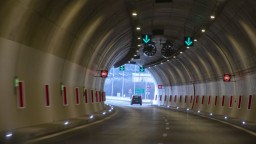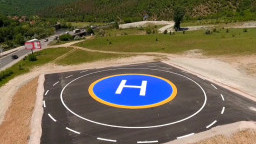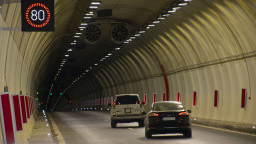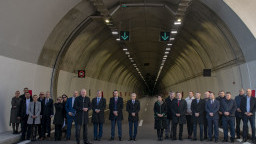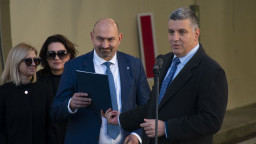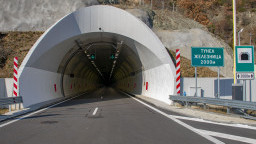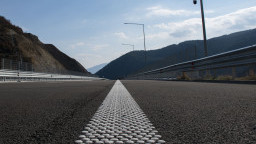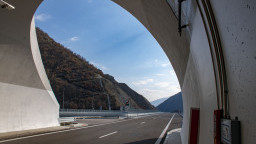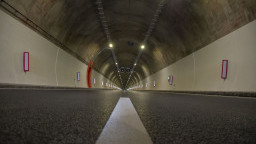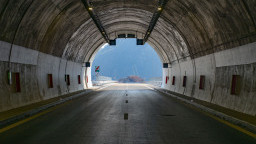The traffic through the longest road tunnel Zheleznitsa of Struma Motorway was launched
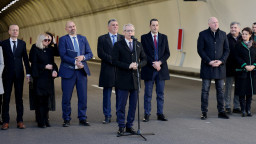
Today the traffic through the Zheleznitsa tunnel of Struma Motorway was launched. The facility is about 2 km long and is the longest road tunnel ever built in the country. Together with the sections before and after the tunnel, 5 km of motorway are put into operation. Struma Motorway is part of the Orient/East Mediterranean Corridor, which connects Vidin with Kulata and carries traffic to Greece. The route is used as the shortest route between Western Europe, Central Europe and the White Sea and also as Europe's link to Asia.
‘This sophisticated technological facility is a step towards the long-awaited connection between Central Europe, through Bulgaria, Vidin, Kulata and Greece,’ Prime Minister Acad. Nikolay Denkov said. He recalled that the highway should have been ready for the Olympic Games in August 2004. That is why construction is a priority for the current government, so that it is certain that Bulgarians will not have to wait another 20 years for 20 kilometres of road. ‘Every day of delay in the completion of the highway creates not only a risk for more lives lost, for more traffic accidents, for more inconveniences for the people who live in the Kresna Gorge, but also creates problems for these habitats that we want to take care of so much and because of that the decision is delayed for years,’ Acad. Denkov said. The prime minister pointed out that talks had been held with the European Commission on the issue. ‘We have proposed a solution that is logical, understandable, environmentally friendly, as pragmatic as possible and we expect a positive decision in the shortest possible time,’ Prime Minister Acad. Nikolay Denkov added.
The Minister of Regional Development and Public Works Andrey Tsekov stressed that the ceremony of launching the traffic through the Zheleznitsa tunnel and the sections before and after it marks a step towards achieving full transport connectivity of Bulgaria with its neighbours, in particular Greece, and in a slightly more distant perspective with the finalisation of our first transport corridor connecting our southern and northern borders. He reminded that the project launched in 2019 has experienced 3 regular and 4 caretaker cabinets, which is, however, a good example of continuity and sustainability in regional policy, as each of these cabinets has contributed to the implementation of a strategic priority for Bulgaria, which improves both the economy and the demography of Bulgaria.
The Regional Minister noted that although the section of Struma Motorway opened today is only 4.4 km long, it is extremely complex in terms of engineering solutions and is indicative of the capabilities of the Bulgarian engineering and technical thought and the capacity of the Bulgarian designers, builders and supervisors, whom he thanked. Tsekov added that 26 km of the highway remain between Simitli and Kresna, for which he expects a decision in the next 2 weeks. He expressed hope that in 2027 or 2028 there will be full highway connectivity between Sofia and our border with Greece, as well as substantial completion of the link to take traffic to the Romanian border. After his opening remarks, Minister Tsekov handed over the certificate for the use of the section to the investor - Road Infrastructure Agency.
With the secured funding under the OP Transport and Transport Infrastructure we are already closer to the connectivity with Greece, the Minister of Transport and Communications Georgi Gvozdeykov said for his part. In his words, due to the geopolitical situation in the region, the transport connectivity along the North-South axis and the completion of the Struma highway are becoming even more important for the economy and tourism.
‘European solidarity is strong not just with the amount of money, but with the added value of the modernisation in which it is invested’, Marina Kirova, Economic Governance and European Semester Advisor at the European Commission Representation in Bulgaria, said. In her words, the benefits of Zheleznitsa tunnel are obvious - more safety and prevention of accidents, reduction of harmful emissions. ‘The part of the Struma motorway built so far with nearly EUR 580 million from the EU cohesion policy reinforces the strategic geographical importance of Bulgaria. The motorway connects Sofia and Thessaloniki, and in a wider context provides a road link between Hamburg, Germany and Thessaloniki, Greece. Besides, the Bulgaria - Greece axis could be part of the solidarity corridors for the transport of goods, imposed on an emergency basis because of Russia's aggression against Ukraine’, Marina Kirova noted. She added that in the future, the EU will continue to support the development of sustainable transport infrastructure and the improvement of road safety in Bulgaria by investing EUR 1.9 billion in more large-scale projects in the programming period until 2027.
The tunnel has two separate traffic tubes. The length of each is about 2 km. The facility has all safety systems, energy efficient lighting, ventilation, CCTV, fire alarm, intelligent traffic management system, emergency SOS booths, electronic access control system etc. Between the pipes there are four cross-connections for pedestrians and two more for cars, where ambulances, fire brigades and other specialized machinery can pass. In the event of an accident or closure of one of the tubes, they will be used to safely remove passengers. A service road was also built at the southern portal of the tunnel from Simitli, a helicopter pad, two bridges over the Suha River, a retaining wall, etc.
The tunnel was built using a new Austrian method. About one and a half metres of each pipe were dug per day and then the primary lining of the facility was immediately constructed with fasteners, sprayed concrete and anchors. Following the traditions in tunnel construction four icons of St. Ivan Rilski were built in. Images of the saint are placed at the beginning and at the end of the two pipes of the facility. Currently, the holy images are not visible as they were covered when the secondary lining of the facility was constructed. The belief when the icons were installed was that they protected the workers during construction on the site, and then all the commuters.
During the construction of the bridge structure over the Struma River before Zheleznitsa, the technology of ‘stroke pushing’ of the reinforced concrete structure was used for the first time in Bulgaria. Its implementation facilitated the passage of the section over 6 obstacles - the Struma River, road I-1 Sofia - Kulata, the railway line Sofia - Kulata, the municipal road Blagoevgrad - Simitli and a service road to the northern portal, without restricting the intensive traffic on road E-79 during the construction. The characteristic feature of this innovative technology is that a work platform is used to manufacture the individual elements, which are lifted and pushed forward by a hydraulic system, each element being mounted in front of the finished one. The viaduct has two separate structures for both directions of traffic. The canvas for Kulata is 510 m long and for Sofia - 560 m. The height of the bridge is between 10 m and 18 m and the distance between the columns is from 45 to 60 m.
Struma Motorway is the first infrastructure site where a helipad has been built. It is about 410 m from the southern portal of the tunnel, travelling from Blagoevgrad to Kulata and 40 m from the I-1 road (E-79). The facility can be reached from the first-class road, via the turnoff at the junction for the village of Zheleznitsa, as well as from the new section of the motorway. The playground is asphalt concrete and measures 40 m by 40 m. It is located at an altitude of 315 metres above sea level and the wind speed in the area - the so-called 'wind rose' in meteorology - was taken into account when determining its exact location. The facility has CCTV and all the necessary security and communication systems, fire alarms, etc. that are part of the Zheleznitsa Tunnel safety systems. Medical helicopters up to 3,750 tonnes will be able to take off and land on the helipad. The maximum weight of one medical air ambulance together with equipment, fuel and crew is about 3,175 tons. The helipad will also be used by helicopters of state institutions - the Air Force for rescue operations in severe or mass accidents, the mountain rescue service and others.
